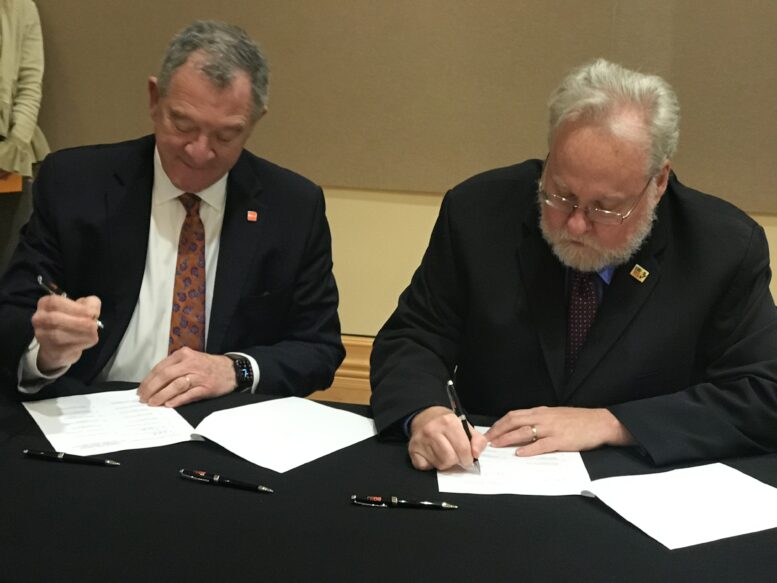By DAVID DUPONT
BG Independent News
Bowling Green State University and the Bowling Green State University Faculty Association have signed their fifth contract since the faculty unionized in 2010.
The contract calls for a 9.24 percent increase over three years starting July 1 and continuing until June 30, 2027.
David Jackson, president of the union, said that those on the lower end of pay scale, including qualified rank teaching faculty, will recent higher percentage of raises. There will be a parity pool to assist long-serving teaching faculty. (Qualified ranked teaching faculty do not have nor are eligible for tenure.)
The pool funds across-the board increases of 2 percent or $2,000 whichever is higher in the first year; 1.5 percent or $1,500 whichever is higher in the second year; and 1.5 percent or $1,000 in the third year. One percent is designated for merit increases.
“Overall, we think it’s a very good and very fair contract,” Jackson said. “The thing that’s most impressive is the progressive way the raises are distributed. Faculty with the lowest salaries and most affected by inflation will receive higher raises in percentage terms.”
The most difficult issue to resolve, Jackson said, is medical coverage. The university is self-insured, so all funds come either from the institution or the employees.
The country has long had “a crisis in the cost of health care,” he said. The BGSU administration has done what it can to contain those cost, but inflation is always a problem.
The medical package remains largely the same with “modest” increases in deductibles and in the maximum out-of-pocket costs, he said.
The way the wage increases are weighted toward lower earners is, in part, an attempt to address those added costs, Jackson said.
“As health care costs increase, we have a common interest to try to find ways to slow that,” said President Rodney Rogers.
The contract for unionized faculty “will inform what we do with other employees. We want to make sure we’re fair and equitable to all employees,” Rogers said. “We do the best we can do to compensate them appropriately knowing the state has put a limit on any tuition changes we can make and have not put significant dollars into the state share of instruction.”
Both Jackson and Rogers praised the cooperative way the negotiations have been conducted in the past negotiation cycles. They have used interest-based bargaining in the past two negotiations.
Both sides, Rogers said, “are focused on the future of Bowling Green State University.”
Rogers said that the contract “cleans up some language so there is less misunderstanding.”
Tuition higher for incoming students
The trustees also voted to increase tuition for students enrolling for the fall semester by 3 percent over what the previous class is paying. That’s the maximum allowed by the state.
The Falcon Tuition Guarantee means they will pay the same amount over the next four years. This is the seventh cohort to fall under the tuition guarantee, said Chief Financial Officer Sheri Stoll.
This raises the charge per credit hour by $16.90 to $498.30.*
A full-time student taking 12-18 credits in the class of 2028 will pay $5,979.60 in tuition and $982.80 in general fees, a total of $6,962.40. The out-of-state fee is $3,994.20, bringing their tuition and fees to $10,956.60.
This rate of increase, Stoll noted, keeps BGSU competitive for total costs among state universities. It ranks as sixth least expensive.
Trustee Howard Traul, however, noted the university’s room and board costs are lower, off-setting higher tuition costs. BGSU has the fourth highest tuition in the state system.
Stoll said that BGSU early on started providing generous institutional scholarships, which amount to tuition discounts.
Rogers said that the cost of providing an “immersive residential program” for students is inherently more expensive, which is why Miami, highest, and Ohio University, third highest, also cost more. They are also the two most expensive Ohio universities in terms of total cost.
New doctorate
The trustees also approved a new Doctorate in Occupational Therapy Program. The program is modeled after the Doctorate in Physical Therapy, and will be housed in the School of Physical Therapy. It is a hybrid program that will allow students take classes, and come for clinical work a couple times a year at BGSU.
The program can be completed in two years, instead of the typical three years.
The first cohort of students will begin in fall, 2025. That first class is expected to have 60 students, future classes are expected to have 80 students.
Jason Hughes, director of the program, said the program should get accreditation in December 2026, a semester before the first class of graduates. That’s the standard timeline, he said.
Provost Joe Whitehead said that this program, like the physical therapy doctorate, fills a need for these practitioners in rural areas by allowing students to earn credentials in those fields without having to relocate.
The creation of the new program is the latest move by BGSU to bolster its offerings in health care.
*This figure was misstated in an earlier version of this story.
(Stories on construction projects and enrollment will be forthcoming.)





